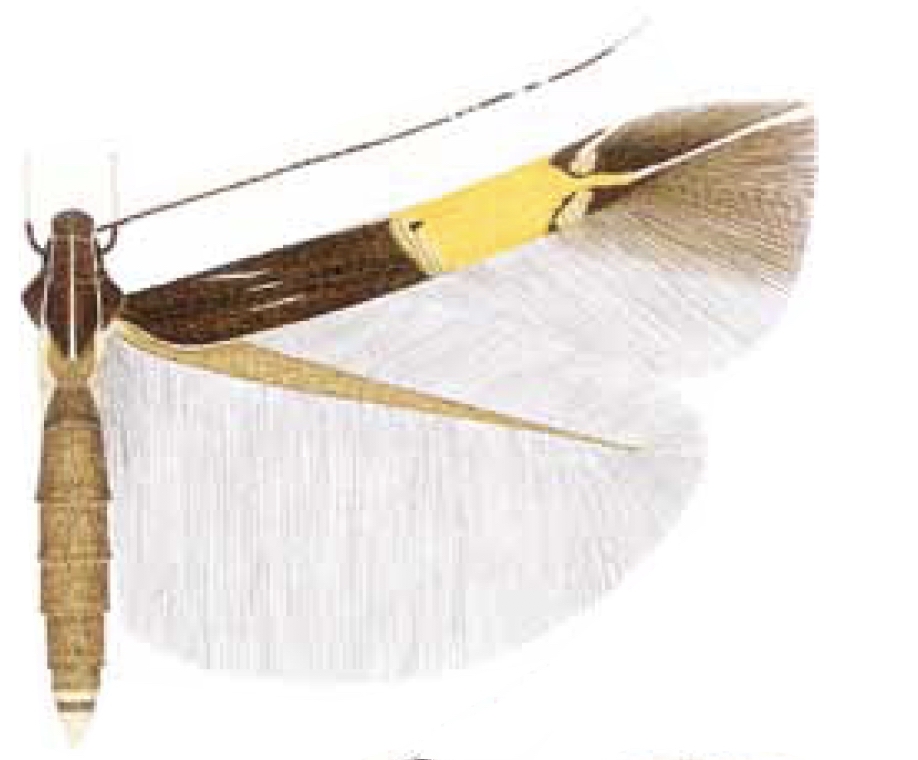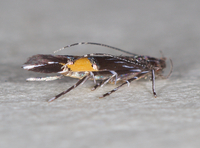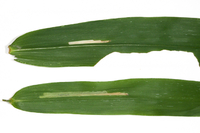Identification
Adult Markings: The following description focuses on forewing and antenna patterning, and is based on a more detailed description presented by Koster (2010). The head and dorsal thorax region have three white lines (two lateral; one medial). The scape is white below and dark brown above with a white anterior line. The antenna is dark brown, with a short white line at the base that changes into an interrupted line that extends to beyond one-half the wing length. This is followed towards the apex by the following sequence: six dark brown segments, two or three white segments, two dark brown segments, two white segments, ten dark brown segments, and eight white segments at the apex. The forewing is dark brown with four narrow white lines in the basal area. These consist of 1) a subcostal line that extends from the base to one-quarter of the wing length and bends away from the costa in the distal half, 2) a short medial line that is above the fold in the center and under the apex of the subcostal, 3) a subdorsal line that is about twice as long as the medial, but slightly further from the base, and 4) a short and very narrow dorsal line from beyond the base to one-quarter the length of the wing. The white lines in the basal area can differ in length, especially the subcostal which starts from the base in the North American specimens and beyond the base in the Neotropical ones. An orange-yellow fascia is present just beyond the middle that narrows towards the dorsum. The facia has a narrow apical protrusion, and is bordered at the inner edge by a tubercular silver to pale golden metallic fascia. There is a small subcostal patch of blackish brown scales on the outside. The outer edge of the orange-yellow fascia is bordered by two tubercular, silver or pale golden, metallic costal and dorsal spots. The dorsal spot is more than three times as large as the costal spot and more towards the base. Both spots are irregularly lined with dark brown on the inside. The transverse fascia, tubercular fascia, and spots are variable in width. There is a narrow white costal streak that extends from the costal spot to the costa. Finally, there is a white apical line that extends from or just beyond the apical protrusion to the cilia. This line is sometimes interrupted in the middle. The cilia are dark brown, but paler towards the dorsum. The hindwing is brownish gray and the cilia brown. Cosmopterix teligera closely resembles several other Cosmopterix species (e.g., C. lespedezae ) and cannot be identified with certainty using external characters (Koster, 2010). Accurate identification is best achieved by using genitalia or by rearing adults from host plants.
Adult Structural Features: The following description of the genitalia is based on Koster (2010). Male genitalia. The right brachium of the uncus has a basal part that is narrow. Apically, there is a large ventral bulge in the middle, then the structure gradual tapers apically. The tip forms a short hook. The left brachium is short and slender with a rounded tip, and is about one-third of the length of the right brachium. The valva is large and semicircular, and the caudal margin is rounded. The upper margin is strongly rounded and the lower margin slightly convex. The anellus lobes are only slightly bent in the middle, and widened and almost rectangular at the apex. The aedeagus is bottle-shaped, and narrows distally to less than one-third of the bulbous part. The basal part is about two-thirds of the length of the bulbous part. The lateral lobes are large, narrow distally, and are about one-half the length of the basal part. Female genitalia. The posterior edge of sternite VII is strongly concave, with a small convex section in the middle. The sterigma is elongate, with the anterior half narrowed. The ostium bursae is round, and ventrally there is a semicircular sclerotization and a medial ridge that widens anteriorly. The ductus bursae is slightly longer than the length of the corpus bursae, with a sclerotized section where it enters the latter. The corpus bursae is oval, and both signa occur as V-shaped sclerotized indentions. The most useful features in the male for distinguishing this species from closely related forms are the large ventral bulge in the middle of the right brachium of the uncus, and the short hooked tip in combination with the large, semicircular valvae and the almost rectangular apex of the anellus lobes.
Adult ID Requirements: Identifiable only by close inspection of structural features or by DNA analysis.
Immatures and Development: The larva forms an elongated, full-depth mine, and expels all of its frass from a hole at the basal end. Pupation occurs within the mine (Eiseman, 2019).
Larvae ID Requirements: Identifiable from good quality photos, especially where associated with known host plants.

 »
»




 »
»


